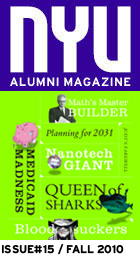comics
Vampires Bite Back
Scott Snyder and Stephen King breathe life into the fatigued phenomenon
by Renée Alfuso / CAS ’06
Between the teen heartthrobs of Twilight and the soap opera sexpots on HBO’s True Blood, “vampire” has become a word that elicits groans and eye rolling instead of fear. But vampires were once sickening monsters, like Bram Stoker’s Dracula, before they became the latest pop-culture craze, and finally there’s a new bloodsucker bringing some horror—and dignity—back to the genre.
In the comic book series American Vampire (Vertigo), which has a special hardcover edition hitting bookstores this month, Skinner Sweet is a vampire who actually scares other vampires, a sociopathic outlaw terrorizing the Old West even before he gets his fangs. This killer antihero is brought to life by Scott Snyder, who teaches a fiction workshop on genre, literature, and comic books called “The Monster Under Your Story” at the Gallatin School of Individualized Study, and the master of horror himself, Stephen King, who is making his first foray into comic script writing. Snyder initially caught the author’s eye when his short story collection, Voodoo Heart (Dial Press), debuted in 2006 to critical acclaim, including from King, who said it “just blew me away.” So when Snyder asked him to write a similar blurb for the Vampire series, King went a step further and offered to pen Skinner’s origin story.
The idea for a new breed of bloodsuckers actually struck Snyder during the previous vampire glut, in the early 2000s, with movies such as Underworld, Queen of the Damned, and the sequel to Blade. “I just got so sick of seeing the same kind of vampire over and over again with the leather trench coats and always going off to some glamorous club or Gothic party,” says Snyder, who became nostalgic for the creatures he grew up with in The Lost Boys, Near Dark, and King’s Salem’s Lot. Those characters were frightening for their familiarity rather than exoticism. So his vampires are American icons—starlets, cowboys, rock stars—whom the story follows through different decades, starting with 1920s-era Hollywood and moving into Las Vegas in the ’30s. The series imagines that vampires have been evolving over time as the bloodline creates new strains, each with their own abilities and weaknesses. In the story, the traditional stake-through-the-heart nocturnal species consists of European nobility who are “as interested in bucks as blood,” and who have been unrivaled for centuries. That is, until Skinner Sweet takes the next evolutionary step to become the first of his kind: an advanced American vampire powered by the sun who no one knows how to kill. With an unhinged jaw, rattlesnake fangs, and elongated claws, Snyder’s creation looks more like a rabid Nosferatu than the sparkly skinned pretty boys of Twilight.
The first five issues of the series feature back-to-back stories that alternate and intersect between King’s background on Skinner in 1880s Colorado and Snyder’s story line about an aspiring silent-film star named Pearl Jones, who meets Skinner nearly half a century later. King was only supposed to contribute one issue but ended up writing more because, he says, the story “really lit up my imagination.” Vertigo accommodated his extensive writing with extra-large issues, and King has expressed interest in returning to contribute when the series reaches the 1950s and ’60s. “The bar was so high with his stuff that it was intimidating,” says Snyder, who’s been a huge fan of King since childhood. “He could’ve easily phoned it in and it would’ve been really good anyway, but he really went to the mat for each issue.”
Snyder says the horror maestro easily adjusted to the new medium and the only occasional problem he had was a case of premature decapitation—tearing the heads off characters before they were supposed to die. But such dark inclinations bring real chills to the pages, as when a hidden opening in the wall reveals bloodied bodies hanging by hooks through their mouths, still begging for mercy. The book is drawn by the artist Rafael Albuquerque, whose previous work includes the comics Superman/Batman and Blue Beetle. To capture the dual eras of the Jazz Age and the Old West in the first cycle, Albuquerque used two styles in each issue: sharp inks and contrasting black and whites for the theatrical feel of Hollywood, and pencil with paint-like washes for the gritty, antiquated texture of a Sergio Leone Western. “I feel like I could write a terrible script and it would still be good on the page because of his art,” Snyder says.
In addition to the series, Snyder is working on a novel that’s due out next year. But for the lifelong comics fan, who attended conventions back when they were just a bunch of guys with foldout tables, he’s happily contracted to write American Vampire for another two years and is now exclusive to DC—home to both Batman and Superman. He says: “I’m constantly bugging them to see if I can come into the office because it really is geek heaven.”
Snyder’s creation looks more like a rabid Nosferatu than the sparkly skinned pretty boys of Twilight.







